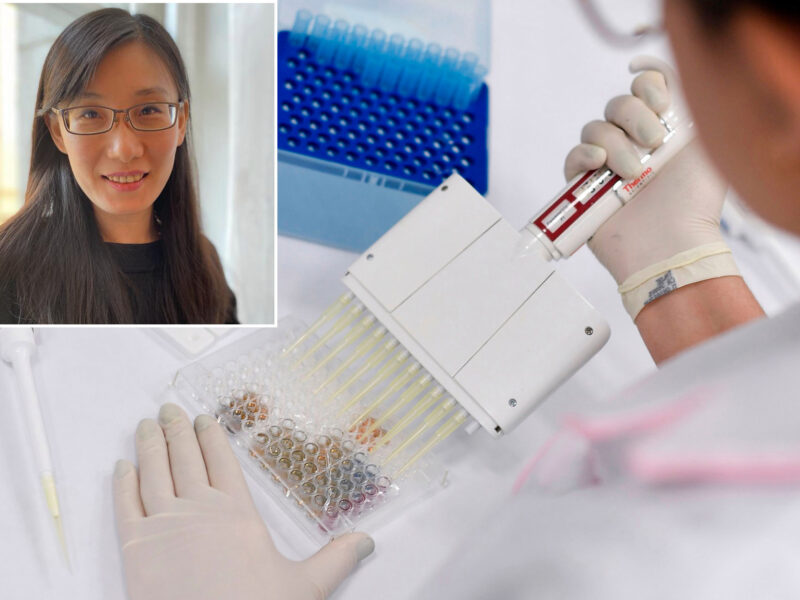
Western experts are weighing in on Chinese whistle-blower Dr. Li-Meng Yan’s report claiming to show COVID-19 was man-made in a lab — with several dismissing it as more of a theoretical think piece that offers no new evidence and includes flawed research.
“One of the major arguments [in the paper] is that [the virus] is so unique, it can’t have been generated naturally, the only explanation is that it’s man-made,” Dr. Gary Whittaker, a professor of virology at Cornell University’s College of Veterinary Medicine, told The Post. “I would push back on that.”
Yan’s report, published late Monday on the website Zenote, says Sars-Cov-2’s unique genome shows it was created in a lab because the specific sequences of the mystery bug aren’t found in nature.
Jason Kaelber, a Rutgers University virologist and an assistant research professor at the Institute for Quantitative Biomedicine, said that’s simply not the case.
“All the weird things about Sars-Cov-2 are completely consistent with the sort of weirdness that happens in wild viruses all the time,” Kaelber told The Post.
“One reason why I haven’t gone looking for explanations of artificial origins is because we knew something like this was going to happen sooner or later,” he continued, citing the recent Zika virus outbreak and MERS in 2012, among others.
“This one is the worst since AIDS but it’s not the first and it won’t be the last. So if all the labs in the world shut down, these things would keep coming.”
Chinese virologist Dr. Li-Meng Yan
Kaelber said Yan writes significantly about an apparent “restriction site” on the virus’s genome — a place where a scientist could cut out a piece from a naturally occurring bug and insert something man made — and dismissed it as just “seeing patterns where no patterns exist.”
“It’s like seeing the blessed virgin in a piece of toast, the restriction sites that she finds are commonly occurring elsewhere in Sars-Cov-2 and in other related viruses and if you were to engineer in restriction sites to manipulate the spike gene, I certainly wouldn’t do it like that, there’s much better ways to do that,” Kaelber said.
Whittaker, who works extensively with coronaviruses that occur in animals, said that the havoc that Sars-Cov-2 causes in the body could raise questions about its origins — but a similar coronavirus found in cats does the same sort of damage.
“It has this wide spectrum of disease outcomes and it’s like nothing we’ve ever seen before but if you look at the disease outcomes in humans and in cats there’s actually a lot of similarities,” Whittaker said.
“[The cat coronavirus] was absolutely naturally acquired. We don’t know how or why but it was absolutely natural… why would anyone design a virus to kill a bunch of cats?” he said. “If it can happen in cats in alphacoronavirus it can also happen with humans in betacoronavirus.”
Other critics noted that the paper was put out by the Rule of Law Society & Rule of Law Foundation — a New York-based group run by accused fraudster Steve Bannon and Chinese dissident and fugitive billionaire Guo Wengui. They said the partnership raises questions about political motivations driving the paper’s release and how the research was funded.
Residents receive COVID-19 coronavirus testing in Ruili in China’s southwestern Yunnan province.
AFP via Getty Images
A staff member places a coronavirus vaccine candidate from Sinovac Biotech Ltd at its booth for display during the 2020 China International Fair for Trade in Services.
REUTERS
Up Next
Close
Jeffrey Epstein was a multi-tasking pervert who watched porn while…
“It does not advance the inquiry. If anything, through its unsound reasoning, its oversold conclusions, and, most important, its sponsorship by Chinese fugitive billionaire [Guo] Wengui, it decreases — not increases — the likelihood the Chinese government will agree to an open and credible forensic investigation of the origins of the virus,” said Richard Ebright, a molecular biologist from Rutgers.
But Whittaker said Yan’s report does offer a detailed explanation on how to grow the virus in a lab, which is sound. While he does lean towards the theory that Sars-Cov-2 occurred naturally, he said it’s too early to completely rule out the potential of it being man made.
He and Dr. Nikolai Petrovsky, an endocrinologist from Australia’s Flinders University, also said Yan’s report provides a solid counterpoint to a March Nature article titled “The Proximal Origin of Sars-Cov-2” that argues there is no way the virus could have been grown in a lab.
“All the tools were there, all the information was there to create the virus, she’s not proving it was created, she’s proving it was possible based on what was available at that time,” said Petrovsky, calling the Nature piece “horribly flawed commentary” that was “political.”
“It’d be even stronger if someone followed the paper” and recreated the virus in a lab based on Yan’s report, he said.
But one of the authors on the Nature article, virologist Dr. Ian Lipkin from Columbia University, told The Post in response that “we’ve explored” the possibility of Sars-Cov-2 being man made and “there’s really nothing else to it.”
“The evidence is not persuasive,” said Lipkin, who worked as an advisor on the feature film “Contagion,” which depicts a pandemic-ravaged world that’s eerily similar to today’s outbreak.
“This is really just shifting focus away from where it needs to be, which is trying to identify how this emerged in nature and what we can do to ensure it never happens again.”
Additional reporting by Isabel Vincent






Leave a Reply